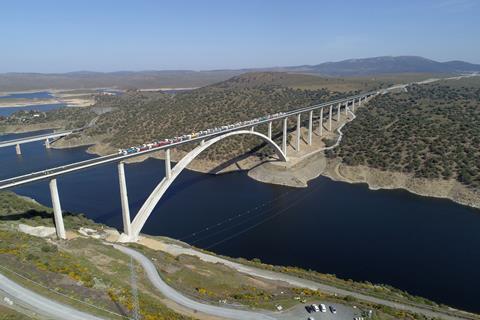
SPAIN: ADIF Alta Velocidad announced on November 23 that it had signed off on the €300m first tranche of a €890m funding package with the European Investment Bank. The loan will support completion of the 282 km high speed line between Talayuela, Plasencia Cáceres, Mérida and Badajoz.
This will eventually form part of the Atlantic Corridor linking Madrid with Portugal, part of the EU’s TEN-T network. The infrastructure is being designed for use by both passenger and freight traffic.
Reflecting the low population density of the Extremadura region, the initial plans for the line to Badajoz had envisaged a single track, non-electrified railway, operated using bi-mode high speed trainsets. But its incorporation into the TEN-T network, and a renewed government focus on carbon emissions means that it will now be taken forward as a double-track electrified corridor. For the time being, 1 668 mm gauge track is being laid on polivalente sleepers which will enable future re-gauging to 1 435 mm.
The 42 km section between Cáceres and Mérida is currently being double-tracked at cost of €6∙2m by Ferrovial Agromán under a contract awarded in early October 2019. In early October this year, the government gave approval for ADIF AV to call tenders for the installation of ETCS Level 2 and ASFA Digital train control equipment for the 245 km section between Plasencia and Badajoz, with a budget of €70∙2m.
ADIF AV and its contractors are also making good progress with tracklaying. By late November, the 58∙8 km of double track between Plasencia and Cáceres was complete, while a single track has been built over the 80 km between Cáceres, Mérida and Badajoz. At Montijo, between Mérida and Badajoz, a junction is to be built to link the high speed line and the adjacent conventional line, which is to be electrified as part of work to modernise the east-west route across Extremadura between Badajoz and Puertollano.
East of Plasencia however, land acquisition and preparatory works have proceeded more slowly. On this section, broad gauge tracks are to be laid as far as Talavera de la Reina, where there would be a junction with the conventional network and a gauge-changer. Passenger trains would then continue over 1 435 mm gauge tracks to join the existing Toledo – Madrid high speed line south of the capital.
Since 2018, ADIF and ADIF AV have invested €426∙9m in the rail network in Extremadura, of which €376∙8m has been spent on new line construction.


















